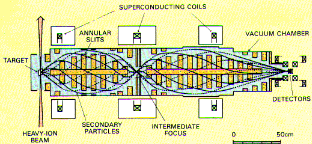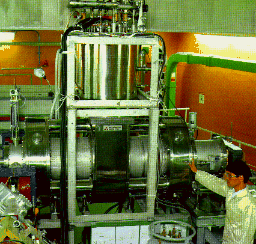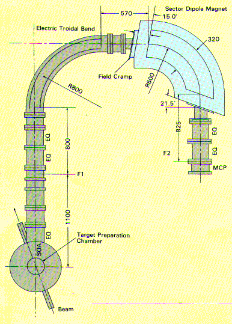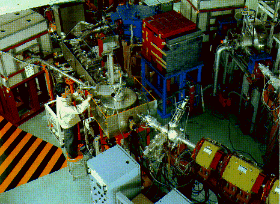
A Spectrometer for the Production of Pions and Muons in Heavy-ion Collisions.
The Large Omega aims at producing beams of pions and muons by means of heavy-ion collisions. This device is a beam channel with an axially sym-metric magnetic field produced by three super- conducting eoils. The large Omega can transport charged particles of selected momentum with a large solid angle of 600 msr. The particles selected are focused on a spot of less than 5 x 5 cm2 , where detectors are placed. Positive muons are coming from the decay of positive pions which are produced in heavy-ion collisions and stopped in the target. The muon yield strongly depends on the low energy pion production cross section. The method to efficiently produce negative pions and muons are under development . Pions and muons have opened up many applied fields such as mu-SR and mu-CF(muon catalyzed fusion).


SLOW: Low Energy Radioactive Beam Channel
This "Slow" beam channel is for the studies of emission mechanisms of varicus low-energy radioactive atoms ftom characterized surfaces. It is also useful in extracting radioactive ions with which one can probe material surfaces. A plane view of the slow beam channel is presented in the figure. Targets are placed at the center of the target prepaTation chamber. Heavyion beams from the RRC are injected into the target at 7OO and are guided to a beam dump. Ions which are thermally emitted from the target surface are accelerated and focused at FI. The target can be heated up to 20OO K. The ions starting from FI are energy-analyzed with an electric troidal bender and are momentum-analyzed with a seetor dipole magnet. A multi-channel plate detector is placed at the second focal point F2 to observe the transported ions. A heavyion induced reaction produces vari-ous kinds of radioactive isotopes in a target at the same time. A part of the radioaetive isotopes produced stop inside the target and reach the target surface by thermal diffusion. Evaporation and ionization of such atoms at the surface are greatly influenced by the surface conditions. This enables the material surface to be studied by measuring these radioactive atoms.


 Return to the home page of
RIKEN Accelerator Research Facility
Return to the home page of
RIKEN Accelerator Research Facility